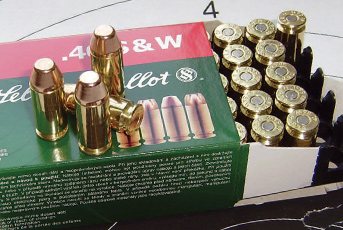Case Histories: 40 S&W
- By Wheelwrite
-
0
 Comments
Comments
- Last updated: 28/11/2016

My favourite modern pistol calibre. It has grunt, it groups, breezes the recently reduced IPSC Major factor, double stacks easily and has comfortable recoil. Having just celebrated its 24th birthday the .40 S&W has quickly come of age. It has already been adopted by police forces and security agencies around the World as a replacement for their aged revolver-based calibres.
The highly publicised shortcomings of their .38 Spl+P cartridge and revolver combo in a notorious 1986 Florida shoot-out led the FBI to search for an alternative carry solution. Working with Smith & Wesson they established a series of tests that would help them evaluate various aspects of performance and then worked their way through a raft of existing ‘handgun’ calibres in semi-automatic pistols.
THE ACCIDENTAL 10
More or less by accident they included the 10mm Auto and later, a downloaded cartridge hybrid that still ticked all their performance boxes. It soon became evident that this reduced load 10mm round could be grafted into a shorter case, permitting its use in medium frame, 9mm type pistols.Smith and Wesson engaged Winchester to do the new cartridge engineering and the .40 Smith & Wesson was born in early 1990 in concert with an S&W Model 4006 semi auto pistol. Austrian pistol makers Glock were quick off the mark with their Models 22 and 23, quickly adapted from the 10mm Auto that was already in their catalogue. Pistols chambered for the new calibre were soon being offered by all the major builders and the rest, as they say, was history.
The rimless case retained the 10mm head design but employed a small pistol primer in place of the former’s large-type. Case length was reduced to a dimension comparable with the 9mm, 21.59mm to the Lugers 19.15mm. The original cartridge had a 180-grain JHP generating just under 1000 fps. As far as I know, every major ammo manufacturer has added the calibre to their inventory. Their range of bullet weights now spanning 155 to 180-grain in JRN, TMJ and JHP. Whilst 200-grain .400” bullets are commercially available and Lee even quote loads for them, they really should not be used in the .40 S&W as the reduced case length leads to both case bulge and the risk of dangerously high pressures.
TAPER CRIMP
The reloading equipment suppliers all offer a suite of tools for the calibre, including a necessary taper crimp. Consumables are also plentiful with bullets as light as 135-grains now offered together with several lead designs. Tales of the .40 S&W being a bit fussy are true - fast powders like 700X and Bullseye do not generate good accuracy. Antique Unique is hard to combust cleanly. Compressed Blue Dot under a 170-grain pill with a Magnum small pistol primer has achieved good accuracy combined with comfortable recoil. Tales of the cartridge blowing up are also true. The blow-up recipe is a combination of hot loads, tired cases and the reduced web support offered by both Glock and Beretta pistols. It is alleged that Federal responded to this issue by stiffening the web of their brass… it works for me.
Whilst revolver makers soon got in on the act with replacement cylinder and moon clip adaptations I’m unaware of any UK legal Section 1 arms currently chambered for .40 S&W. However, Armalon Ltd would probably make you one of their PC Carbines in this stubby 10mm derivative!
